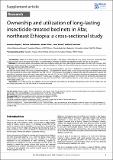| dc.contributor.author | Negash, Kasshahun | |
| dc.contributor.author | Haileselassie, Berhane | |
| dc.contributor.author | Tasew, Awoke | |
| dc.contributor.author | Ahmed, Yesuf | |
| dc.contributor.author | Getachew, Medhanit | |
| dc.date.accessioned | 2021-08-16T22:34:24Z | |
| dc.date.available | 2021-08-16T22:34:24Z | |
| dc.date.issued | 12/25/2012 | |
| dc.identifier.citation | : Kassahun Negash, Berhane Haileselassie, Awoke Tasew, Yesuf Ahmed, Medhanit Getachew. Ownership and utilization of long-lasting insecticide-treated bed nets in Afar, northeast Ethiopia: a cross-sectional study. Pan Afr Med J. 2012;13(Supp 1):9 | en_US |
| dc.identifier.issn | 1937-8688 | |
| dc.identifier.uri | http://dspace.amref.org/handle/123456789/60 | |
| dc.description | This article is published as part of the supplement “AMREF´s evidence in advancing the health of women and children”
Supplement sponsored by AMREF - African Medical and Research Foundation
© Kassahun Negash et al. The Pan African Medical Journal - ISSN 1937-8688. This is an Open Access article distributed under the terms of the Creative Commons Attribution License (http://creativecommons.org/licenses/by/2.0), which permits unrestricted use, distribution, and reproduction in any medium, provided the original work
is properly cited. | en_US |
| dc.description.abstract | Introduction: Malaria is the leading cause of morbidity and mortality in Afar Region. Distribution of Long Lasting Insecticide Treated Bed Nets
(LLINs) has been one of the major interventions to combat malaria. However, ownership and utilization of these nets are not well known.
Methods: A community based cross-sectional study was conducted using interviewer-administered questionnaires to study LLIN coverage. After
systematic random sampling of the study population, data on utilization of LLINs and factors influencing this utilization were collected. Analysis of
these data was done using SPSS software.
Results: Household possession of at least one LLIN in the surveyed households was found in 648(86.1%) households. Ownership of at least
two nets was found among 419(55.6%) surveyed households. The proportion of children under 5 years of age who slept under treated nets during
the night preceding the survey was 728(82.0%) and 676 (76.1%) in the surveyed households for reported and observed respectively. Likewise, the
proportion of pregnant women who slept under treated nets was 166 (79.1%) and 147(70.0%) for reported and observed respectively. Among the
potential determinants explored regarding utilization of LLINs, age, occupation, and radio possession were found to be significantly associated with
LLIN utilization. Households that did not possess radio were 0.38 times (95%CI= 0.25-0.59) less likely to let their children under five and pregnant
women sleep under LLIN.
Conclusion: The LLINs coverage and utilization among the pastoralist community are promising. Strengthening of the primary health care unit
and timely replacement of LLINs are critical for improved outcomes. | en_US |
| dc.language.iso | en | en_US |
| dc.publisher | Pan African Medical Journal | en_US |
| dc.subject | Determinants | |
| dc.subject | Utilization | |
| dc.subject | Ethiopia | |
| dc.subject | Long-lasting insecticide-treated nets | en_US |
| dc.title | Ownership and Utilization of Long-lasting Insecticide-treated Bed Nets in Afar, Northeast Ethiopia | en_US |
| dc.title.alternative | A cross-sectional study | en_US |
| dc.type | Article, Journal | en_US |

